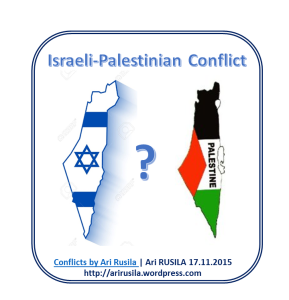 During last two decades Israeli-Palestinian conflict has been a serial of repeated failures reaching peace agreements and implementing e.g. Oslo accords, combined with varying levels of violent confrontations. There is deepening lack of trust between Israelis and Palestinians and more blaming the other side.
During last two decades Israeli-Palestinian conflict has been a serial of repeated failures reaching peace agreements and implementing e.g. Oslo accords, combined with varying levels of violent confrontations. There is deepening lack of trust between Israelis and Palestinians and more blaming the other side.
This year marks 100 years from the first international acceptance of Zionism in the form of the Balfour Declaration, 70 years since the UN partition resolution, and 50 years since the Six-Day War in which Israel – defending itself – conquered and subsequently occupied the West Bank. It might be a right time to search a new approach for solution. Some aspects of this might be found from Israeli-Palestinian dialog hosted by BICOM, updated constructive unilateralism and my revised hybrid model based on mainly these two developments.
The new “hybrid” approach to Israeli-Palestinian peace-making
In late 2016, BICOM hosted a series of private, track-two dialogues between current and former Israeli and Palestinian officials and academics designed to explore new thinking and provide a detailed critique of different ideas to solve the conflict.
Based on these unique discussions, the BICOM research team published on 31st March 2017 a policy paper proposing a new “hybrid” approach to Israeli-Palestinian peace-making.
The dialog analysed and critiqued four models for Israeli-Palestinian peacemaking: Bilateral negotiations focused on agreed parameters; a regional framework; constructive unilateralism; and Israeli-Palestinian confederation. The analysed four models, their descriptions and limitations added with my comments, are presented below as infographs:
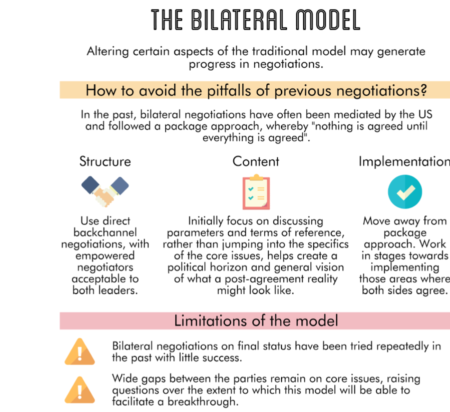
Comment: Two decades of failures show that with this the progress is non- existing and going even backwards.
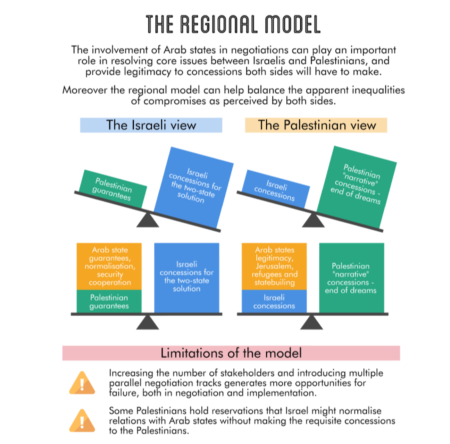
Comment: The Arab Peace Initiative of 2002 offers Israel with diplomatic recognition from 57 Arab states in return for a statehood deal with the Palestinians. The Saudi proposed Initiative was supported by the Arab League at the Beirut Summit 2002 and endorsed again in 2007 by the Arab League Summit. Recently all 15 resolutions passed by the Arab summit on 29th March 2017 were devoted to an indictment of Iran, its Revolutionary Guards Corps and Lebanese surrogate, Hizballah. None of the formal resolutions addressed the Palestinian-Israeli conflict. However in a separate statement issued later, the Arab rulers reaffirmed their commitment to a two-state solution of the Arab-Israeli conflict. According DEBKAfile this was the first Arab summit to refrain from defining Israel’s future borders under a peace deal. This leaves the door open for leeway in the negotiations to take place as part of the new US-Saudi-Egyptian peace initiative.
I support regional model but with different content: Instead of Arab League the key players should be Israel, Egypt and Jordan as then the content could be implementation Sinai option for Gaza and Jordanian option for West Bank.
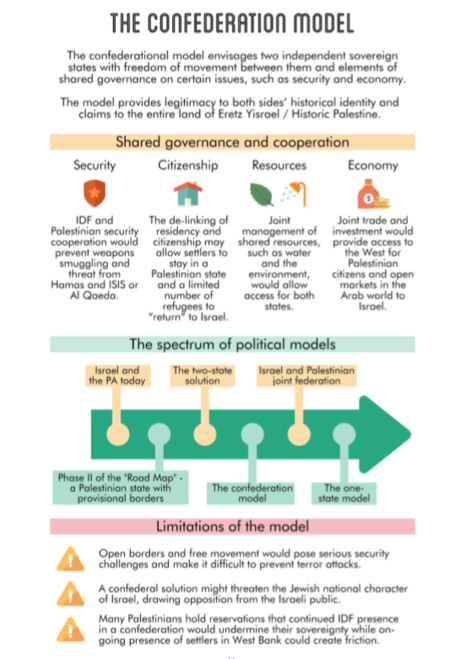
Comment: The difference between Herzl’s generation and post-1948 generations was a first-hand understanding of what the absence of a Jewish state means for Jewish survival. The state represents the difference between autonomy and servility, indeed between life and death. In my opinion Israel-Palestine confederation model would be too close one-state solution which would destroy Israel as “Jewish” state. Instead of this model I see Palestine-Jordan confederation much more better alternative.
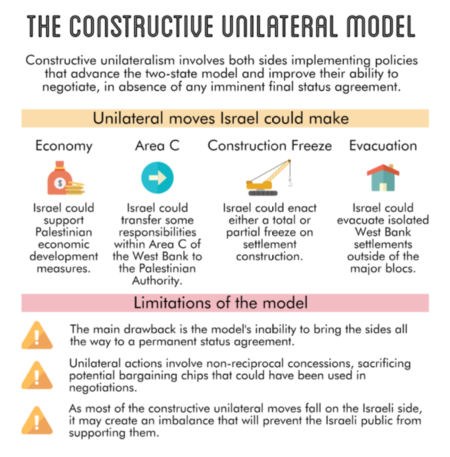
Comment: In my opinion the best way forward. I don’t see constructive unilateral steps as goal but more as strategy and process which will lead towards a comprehensive agreement.
“Hybrid” model
While there was little appetite for returning to the classic bilateral negotiation model without prior agreement on parameters, extensive analysis and critiques of each model did generate an interest in continuing to explore the potential of a “hybrid” model, creatively drawing upon components from each of the four different models discussed. Such a hybrid model would involve a regional framework for a peace process composed of a strategically creative deployment of genuinely constructive, and sometimes coordinated, unilateralism, and bilateral negotiations that move from framework agreements through incremental implementation to final status talks.
The advantage of such a model lies in its combination of designing a political horizon or endpoint while harnessing the flexibility of constructive unilateralism, which might begin on a small-scale. Moving away from sequential to parallel incentives, as the Arab League has recently done in the Arab Peace Initiative, and shedding the mantra of ‘nothing is agreed until everything is agreed’, would also introduce more flexibility into the process. Finally, seemingly radical proposals found within the confederative model – such as allowing some Israeli settlers to remain in a Palestinian state with a similar number of Palestinian refugees residing in Israel – may also form part of this model, helping to resolve some hitherto intractable core issues.
Comment: I agree that none of the four models alone will bring a comprehensive agreement for Israeli-Palestinian conflict and so a new hybrid approach is needed. Besides comments above my conclusions about the content of that “hybrid” model differs from above described outcome of BICOM -dialogue. Below I highlight some aspects of constructive unilateralism, settlement and economic questions, and regional approach in order to develop a better revised version of “hybrid” model.
The full paper of BICOM dialogue is available as a PDF below:
Download PDF
Constructive unilateralism updated
Blue White Future co-chairmen Gilead Sher and Orni Petruschka argue that the two-state solution is in political trouble but it is still achievable and imperative to the respective parties. However a different paradigm is needed, one that is not based solely on bilateral negotiations towards a fully-fledged Permanent Status peace agreement and thus does not require mutual trust as a necessary condition for progress.
According Sher and Petruschka a more realistic target – than a comprehensive agreement – is a ‘divorce’ two-state agreement between the parties, focused on phased separation between the sides and an absence of violence.
Instead of moving towards an agreement to two states, we need to define our goal as moving towards a reality of two states, and to advance gradually towards that goal. This approach consists of constructive steps that each side can take, independently of the other, in order to advance a situation – both on the ground and in the political realm – which is closer to two states. This paradigm calls for an increased role of the international community, which should provide a clear vision of the final end goal of an agreement – along the lines of the recent John Kerry six-point speech – and of the ways it will benefit both parties. In addition, the international community should also push the parties to make independent progress towards that destination. In other words, a continuous process that comprises transitional stages while moving steadily in the right direction should be initiated, facilitated, and supported. The respective independent steps should not be considered an exclusive route but rather a complementary – and eventually alternative – component within the context of regional and bilateral negotiations.
Source: Fathom
According Sher and Petruschka constructive independent steps towards a reality of two states could on the Palestinian side involve building governmental institutions of the future Palestinian state; curtailing any incitement within their educational and political systems; working towards a fully functioning democracy which includes all factions that denounce violence. On the Israeli side, one constructive independent step would be to announce that it has no claims of sovereignty outside of the main settlement blocs and to the east of the security barrier i.e. on an area that totals approximately 90 per cent of land the West Bank. Such a statement would carry much more significance than a temporary settlement freeze because it would result in a de-facto cessation of settlement activity in the relevant remote areas outside the blocs.
The settlement question can be solved be constructive unilateral steps
Construction activity by Israelis beyond the so-called “Green Line” of 1967 (aka the Armistice Line of 1949) is claimed to be a breach of international law as well an obstacle to peace. However widely it is presumed that Israel will retain high Jewish population centers in the West Bank, known as the blocs, in any final status agreement for a two-state solution with the Palestinians.
For any Israeli government it is necessary to coordinate its actions with the mainstream settler community. The approximately 590,000 Jews living beyond the Green Line can be divided into three groups. The first group is the approximate 200,000 Israelis who live in the 12 Jewish neighbourhoods of East Jerusalem, which will undoubtedly remain under Israeli sovereignty in any agreement. The second group is some 300,000 settlers who live in the so called ‘settlement blocs,’ located west of the security barrier which are usually very close to the Green Line. The vast majority of these settlements are also likely to remain under Israeli sovereignty. Only the third group, comprising 90,000 settlers – less than 20 per cent of the entire population of those living beyond the Green Line – who live beyond the route of the security barrier, needs to be addressed at the present time. These numbers are significantly fewer than the supposedly prohibitive numbers that are often quoted and regarded as an insurmountable obstacle. (Source: Fathom )
According Sher and Petruschka cessation of settlement activity outside the settlement blocs would restore sincerity to Israel’s discourse about the two-state solution. Furthermore, it would convey a crucially important message to the settlers who live in these areas that their current place of residence will eventually not be part of the State of Israel. Such a policy would also immediately require the government to compensate the settlers and offer to relocate them to ‘Israel proper’. Hence, the statement that Israel is relinquishing any long-term territorial claims of sovereignty over the areas located outside of the settlement blocs will necessitate enacting a law that enables voluntary relocation and includes considerable compensation for the settlers.
The Israeli government’s new policy as constituting self-imposed restrictions that will “significantly limit the expansion of settlements beyond the footprint of existing settlements” and not to establish new communities in the West Bank can be seen as respecting US President Donald Trump’s concerns over unfettered settlement construction, and in order to “allow for the advancement of the peace process. At minimal level this policy will mean that Israel may not build in West Bank Area A (the major cities under Palestinian control) and Area B (under Palestinian civilian control and Israeli security authority), and not establish new settlements or outposts.

Economic aspect
Prof. Hillel Frisch is a professor of political studies and Middle East studies at Bar-Ilan University and a senior research associate at the Begin-Sadat Center for Strategic Studies. In his BESA Center Perspectives Paper No. 425, Becoming Part of Jordan and Egypt: A Palestinian Economic Imperative he argues that reintegrating into the Jordanian state is an economic imperative for the Arab inhabitants of the Palestinian Authority. Only by once again becoming citizens of Jordan will they be able to challenge the economic stone wall imposed by domestic Jordanian economic lobby groups barring West Bank exports. A two-state solution would lead, not to an economy of peace, but to an economy of violence as lobby groups in both Israel and Jordan shut out the Palestinian state’s exports. The Palestinian state would inevitably react by threatening and committing violence to extract the international aid to which the PA has become accustomed.
While the Palestinians’ economic welfare is ostensibly fairly good, it is a matter of serious concern that neither in Gaza nor in the PA is that status determined by a functioning domestic economy. By far the most important element propping up Palestinian economic welfare levels is financial aid as international donors such as USAID, the EU, individual EU member states and church-related NGOs are ready to foot the bills – roughly one-third of GNP in the West Bank and considerably more in Gaza. In addition there is substantial dividends derived by the 100,000-150,000 West Bankers who work in Israel at far higher wage levels than can be earned in the PA itself. However economic aid in conflict situations often feeds violence directly and indirectly as e.g, arms, smuggling and attack tunnels in Gaza and social aid for familes of WB terrorists are financed by Iran and other donors.
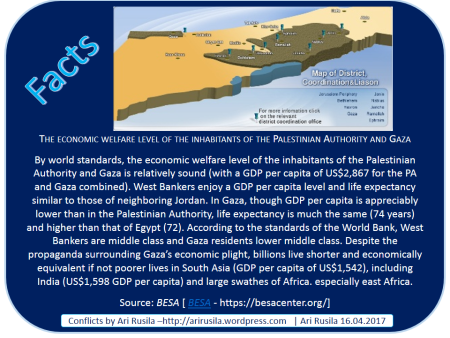
According Prof. Frisch if a Palestinian state comes into being, the manufacturers in the PA and Gaza are shut out from their most important markets: Jordan and Egypt. Prof. Frisch claims that it is Palestinian business groups – Jordan’s major entrepreneurs – who lobby to shut out West Bank industrialists from Jordan’s commercial market. In Egypt, lobby groups act the same way. This is why the import-export trade volume between the PA and Jordan is miniscule and has hardly changed in twenty years. In 2015, total trade between the PA and Jordan stood at a paltry US$167 million. PA exports to Jordan amounted to US$60 million against US$107 million in imports from Jordan. PA exports to Jordan comprise less than 7% of total PA exports. PA exports to the markets of Arab states beyond Jordan, mainly the wealthy Gulf states are only US$61 million, whereas Jordan exports over US$2 billion to Saudi Arabia and Iraq alone.
Prof. Frisch claims that tThe inhabitants of the PA clearly have to be reintegrated into the Jordanian state and that the imperative for reintegration into Egypt is even more dire for Gaza. Only as citizens of the Kingdom do West Bankers have any chance of fighting the shutout and creating a functioning economy geared towards peaceful pursuits. Only the Jordanian option, embedded in a wider regional cooperative setting – for example, one that would commit Israel to allow West Bankers to continue enjoying access to the Israel labor market – can ensure an economy of peace.
More about this in BESA Center Perspectives Paper No. 425, March 15, 2017: Becoming Part of Jordan and Egypt: A Palestinian Economic Imperative By Prof. Hillel Frisch; View PDF
Some aspects also in articles Luxury Alongside Poverty in the Palestinian Authority by The Jerusalem Center, November 5, 2015 and Instead of Gaza’s Reconstruction Donor Aid Finances Terrorism And Corruption
The [revised] “hybrid” approach to Israeli-Palestinian peace-making
Two months ago I described in my article Israel-Palestine Conflict: Regional Approach how the Palestinian leadership was holding intense deliberations, both internally and also with its Arab allies, primarily Egypt, Jordan and Saudi Arabia. According to a senior Fatah security official, Ramallah, in conjunction with its Arab partners, decided to take Trump at his word about the regional approach. Together with Egypt it will suggest to Washington an outline of a new regional approach.
This new outline is based on three principles. The first principle is that the basis for future peace negotiations is the Arab Peace Initiative of 2002. Then, on this basis, the second principle is the US administration should hold in the coming months a summit in Washington with the Arab leadership. This summit should focus on preparing a regional peace conference leading to Israel-Palestinian negotiations based on the Arab Peace Initiative, with the participation of Egypt, Jordan, Saudi Arabia and Morocco, chaired by Trump. The third principle concerns advancing the Palestinian statehood issue through an attempt to reach a Palestinian-Jordanian confederation agreement backed by the Arab League. (Source and more in Al-Monitor )
Nearly an year ago – 22nd May 2016 – former Jordanian Prime Minister Abdelsalam al-Majali, who negotiated the peace deal with Israel in the 1990s, announced that he personally believes that confederation between an independent Palestine and Jordan is the best option for both people.
He was quoted by a Palestinian news agency as declaring before 100 Nablus notables that Israeli Prime Minister Benjamin Netanyahu had repeatedly called on Jordan to adopt the confederation option with the Palestinians immediately, and that Jordan had rejected the idea. For Majali, confederation means “a joint legislature and a joint government with equal representation whereby the upper authority will have three main missions — se curity, economy and foreign affairs — and the rest will be the jurisdiction of the joint government.” He also said, “In a confederation, centralization will have to end and the people will have the ultimate choice of how to govern themselves.” (Source: Al-Monitor , more background in Palestinians Put Jordanian Option on the Table )
According Middle East Monitor (MEMO) report [01 September 2014 ] Egypt offered Palestinian Authority’s President Abbas a Palestinian state in Sinai. Egyptian President Abdel-Fattah el-Sissi offered Palestinian Authority 620 square miles of land adjacent to Gaza in exchange for relinquishing claims to 1967 borders for the purpose of establishing a Palestinian state. PA President Abbas reportedly rejected proposal. Speaking in a meeting of Fatah leaders in Ramallah, Abbas said: “The plan, which was proposed in 1956, included annexing 1,600 square kilometres from the Sinai Peninsula to the Gaza Strip in order to receive Palestinian refugees.” He continued: “The plan is being proposed again, but we refused it.” One idea with offer was to resettle “Palestinian refugees” in the Sinai.
The geographic juxtaposition between Israel and Jordan should make delineating the border between the two countries in an agreement considerably easier than reaching a deal on a border between Israel and a planned Palestinian. If Jordanian option will be implemented so Israel would receive security guarantees from Jordan’s monarchy, which made peace with Israel in 1994, rather than from a politically enfeebled Palestinian president; if also Sinai option will come reality so security guarantees will be from Egypt, which has peace deal with Israel since 1978, rather than from outside supervised Hamas. Indeed – if both Jordanian and Sinai options were realized the outcome would be Three State (return) Option , which I have been advocating earlier as the most pragmatic solution to Israeli-Palestinian conflict.
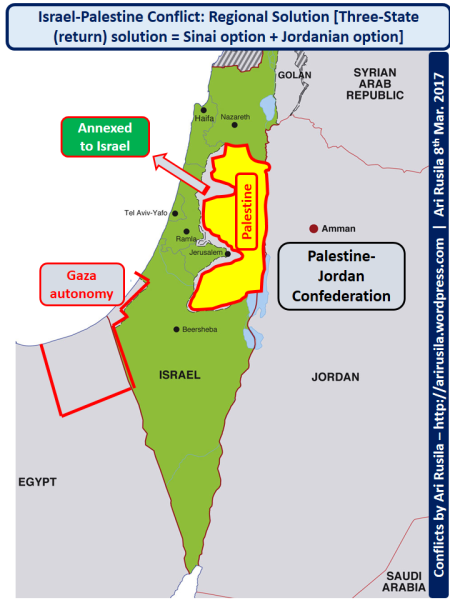
My conclusion
From my point of view “regional peace process” can be implemented by Egypt, Jordan and Israel and instead of Arab Peace Initiative be based on Sinai and Jordan options. Also in my opinion Israel-Palestine confederation model – as described in BICOM analysis – would be too close one-state solution which would destroy Israel as “Jewish” state. Instead of this BICOM alternative I see Palestine-Jordan confederation much more better model.
Regional approach does not need – necessary – to be based on Arab Peace Initiative of 2002. A consequent absence of a peace process might create the conditions for the emergence of a new paradigm to replace the defunct “two-state solution.” This new paradigm I call as [revised] “hybrid” approach to Israeli-Palestinian peace-making.
The traditional paradigm of bilateral Israeli-Palestinian negotiations aimed at achieving a final status agreement is in deep disarray. Two-State solution and the roadmap towards it seems to be the dead end at least in the short term and sure with its outdated version. My conclusion is that now is the right moment to explore the regional alternative based on Jordanian and Sinai options. If there is no progress during coming months then the best way forwards from my perspective is Israeli unilateral actions hopefully based on “Constructive Unilateralism” approach (more in Constructive Unilateralism (II) as Solution to Israeli-Palestinian Conflict).
Related background papers:
Fathom has published an eBook – Two States for Two Peoples – a collection of essays and interviews drawn from the pages of Fathom focused on the two-state solution and how to reinvigorate it. To download the eBook, click here.
The new “hybrid” approach to Israeli-Palestinian peace-making by BICOM
BESA Center Perspectives Paper No. 425, March 15, 2017: Becoming Part of Jordan and Egypt: A Palestinian Economic Imperative By Prof. Hillel Frisch; View PDF
Israel’s 5 Strategy Options Regarding West Bank After Abbas
Trump Presidency Brings Realpolitik Back To Mid-East
Constructive Unilateralism (II) as Solution to Israeli-Palestinian Conflict
Herzog’s Plan: Security Barrier Around the Major Settlement Blocs of West Bank
Analysis: Resolving The Israeli-Palestinian Conflict


